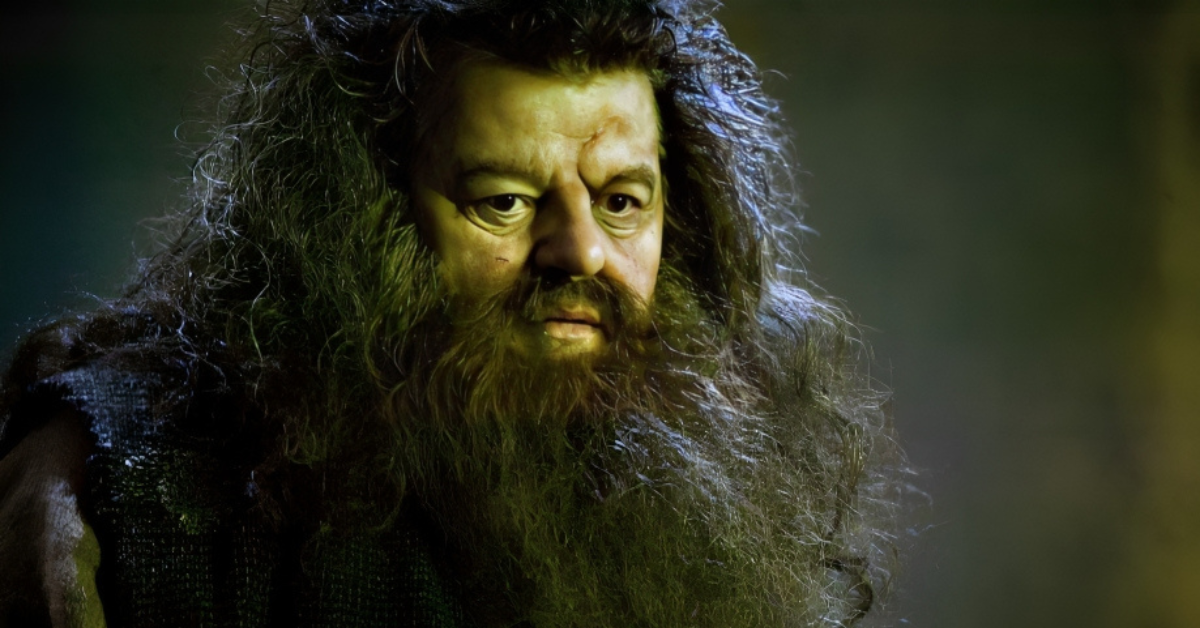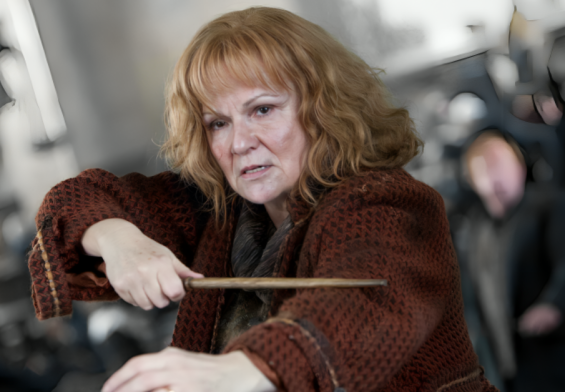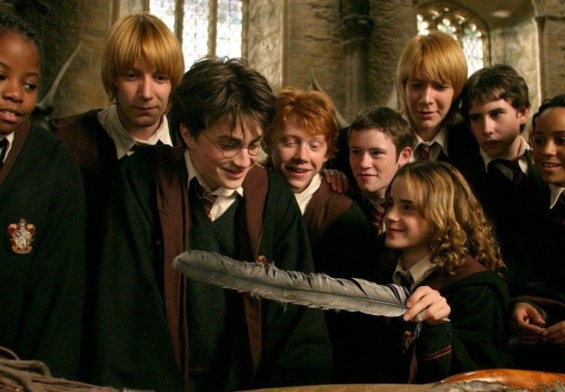
Rubeus Hagrid, the beloved half-giant, is a character that has captured the hearts of readers and viewers alike. With his towering stature, wild mane of hair, and gentle nature, Hagrid serves as the Keeper of Keys and Grounds at Hogwarts School of Witchcraft and Wizardry.
Known for his unwavering loyalty to his friends, his fondness for magical creatures, and his penchant for getting into comical mishaps, Hagrid plays a crucial role in shaping the lives of Harry Potter and his friends as they navigate the trials and tribulations of the wizarding world.
On the whole, we don’t know that much about him. We learn a bit about his past and pick up some interesting pieces of info here and there, but a lot seems unanswered.
This is why he’s the perfect candidate for theories. What really happened to his wand? Where did his mother go? Is it possible that Hagrid was another wizard that Voldemort feared?
Today, we’re going to explore five of the best Hagrid theories circulating the internet. So sit back, relax, and enjoy.
Recommended for You:- The Wizard World’s Biggest Mystery: Where Is Herpo’s Horcrux?
- Why Were the Weasleys So Poor? The True Story Behind Their Struggles
- Why Snape’s Avada Kedavra DIDN’T KILL Dumbledore
1. Hagrid spread the legend of Harry’s scar
Harry Potter’s legendary scar plays a significant symbolic and narrative role throughout the series.
The lightning bolt-shaped scar on Harry’s forehead, the result of a failed curse by Lord Voldemort, is a prominent physical feature that serves as a constant reminder of the traumatic events of his childhood.
It also serves as a visual representation of Harry’s identity and destiny, making him instantly recognizable in the wizarding world.
The scar on Harry’s forehead also becomes synonymous with his identity as the Boy Who Lived. But what’s curious about Harry’s scar is that seemingly everyone in the wizarding world knows about it before he enters their world.
When Hagrid picks Harry up and takes him to Diagon Alley for the first time, he’s almost immediately recognized by his scar. The issue here is that, up until this point, Harry has spent all of his time with the Dursleys.
Redditor StrawberryBrooks had an interesting perspective on the matter:
But, very few witches or wizards could have ever even seen it before he got to Hogwarts, right?
Between Voldemort’s attack and arriving at the Dursleys that fateful night, the only ones who saw Harry were Dumbledore, McGonagall, Hagrid, and Sirius Black.
So how does literally everybody in the wizarding world know about the scar? Sirius is out of the question, and I highly doubt either McGonagall or Dumbledore would have gone around telling everybody about it.
The only possible conclusion I can draw is that, over the years, our friend Rubeus Hagrid visited wizarding pubs far and wide, sharing pints and regaling the tale of how he heroically rescued young Harry Potter from the wreckage left by You-Know-Who.
How he soared towards the stars on his flying motorbike with Harry in his lap. How he looked down and saw etched into the infant’s forehead the last mark of the Dark Lord—a perfectly shaped lightning bolt.
To me, this theory makes perfect sense. After all, Hagrid didn’t hesitate when it came to filling in Harry himself on the scar’s origins:
Never wondered how you got that mark on your forehead? That was no ordinary cut. That’s what you get when a powerful, evil curse touches you. Took care of your mom and dad and your house even. But it didn’t work on you, and that’s why you’re famous, Harry.
We also know that Hagrid is famously bad at keeping secrets.
Should not have said that.
2. Hagrid’s mother was small
There are a lot of unanswered questions out there about Hagrid, but among the most intriguing is how he was conceived. You see, Hagrid’s father was a wizard and his mother was a giantess—an uncommon sort of relationship that came with obvious physical obstacles.
At some point prior to Hagrid’s birth in 1928, Hagrid’s mother, Fridwulfa, first met Hagrid’s dad, a man that we only know as Mr. Hagrid. Although giantesses and men had been known to wed each other, it wasn’t a very common practice. As you might have guessed, both factions frowned upon these sorts of marriages.
In the wizarding world, there was a great degree of prejudice directed towards giants. Even the giants, who valued size and power above all else, looked down on their peers who married “weak” human wizards, which makes her marriage to Hagrid’s father all the stranger.
But Fridwulfa and Mr. Hagrid actually gave their relationship an honest attempt and they were happy for a while. However, in December 1928, when Fridwulfa and Mr. Hagrid welcomed their son Rubeus into the world, something changed.
In giant culture, they prided themselves on having the largest, strongest babies. After a quick glance at the infant Rubeus, Fridwulfa realized that she had failed. As a half-giant, Rubeus was a fraction of the size of other giant babies.
By the time Hagrid was three years old, it became glaringly apparent that he would never grow to the same size as other giants, which caused Fridwulfa’s loyalty to falter. Ashamed by her child’s small stature, Fridwulfa decided to run away and fled back to her giant colony.
But here’s the issue: I don’t think that Fridwulfa herself was all that big. I think that among the giants, who averaged 25 feet in height, Fridwulfa was only 16 feet or so.
In the Order of the Phoenix, we meet Hagrid’s half-brother Grawp for the first time, and something that I immediately noticed was that Grawp was only about 16 feet tall.
Given that the majority of fully grown giants are 25 feet and Fridwulfa produced children of 16 and 11 1/2 feet respectively, I suspect that she may have had the dwarfism gene. This could explain how she could have had a relationship with a human and why her children were smaller than average.
Redditor CaptainJK said the following:
Fridwulfa the giantess has the dwarfism gene and Hagrid and/or Grawp are dwarves. Dwarf is a broad term, but in humans, it generally means a person who, due to a variety of genetic disorders, is under 4’10”.
More specifically, people with disproportionate dwarfism may have larger heads and shorter or stockier arms and legs.
Now, onto Hagrid and Grawp. We know from The Philosopher’s Stone that Hagrid is twice the size of a normal man with hands the size of dustbin lids. This puts him between 11 and 12 feet tall, while his hands are disproportionately enormous.
Next, look at Grawp. His head looks like a boulder, his teeth the size of half-bricks, and he is generally odd-shaped. He stands at 16 feet tall. Meanwhile, other giants like Karkus are listed as being closer to 25 feet tall.
We don’t know what they look like and whether or not they’re disproportionate like Grawp size-wise. However, Grawp is about 20 to 25% shorter than the average giant, putting him well into the dwarf category.
3. Voldemort feared Hagrid
I know, I know. When you consider the demeanor of both men, this seems ridiculous.
Giants have many physical advantages that make them one of the most powerful creatures in the wizarding world. Firstly, giants are incredibly large and physically imposing, with immense raw strength that is proportionate to their size.
Secondly, giants are highly durable and resistant to damage. Spells that would incapacitate or harm normal creatures may have limited effects on giants, making them formidable opponents in battle.
Finally, giants have heightened senses. Their hearing and sense of smell are stronger than those of normal humans, making them more aware of their surroundings and better able to detect danger or prey.
If you add those obvious physical advantages with the ability to cast spells, well then you’ve got yourself a pretty powerful individual.
I think this is exactly what a young Tom Riddle feared—the prospect of a giant wielding magic running around in a world that he wanted to rule. This is precisely why I think he framed Hagrid for opening the Chamber of Secrets to undermine Hagrid’s magical education.
Redditor Clay_Pidgeon said the following:
A fully realized Wizard Hagrid with complete training would’ve been able to cast highly powerful magics with great precision for long periods of time, with great physique and a gift with creatures to boot, and loyalty to Dumbledore means there’d be a hard counter to much of the Inner Circle running around.
This being the stage where Tom Riddle is already laying the groundwork for Lord Voldemort’s rise, it only makes sense he’d remove such a threat before it can truly rise.
4. Dumbledore repaired Hagrid’s wand
In the aftermath of being framed for opening the Chamber of Secrets, Hagrid was expelled from Hogwarts and forbidden by the Ministry from using a wand ever again.
The fate of Hagrid’s wand has been left somewhat up to speculation. All we know is that upon his expulsion, it was snapped into pieces and not confiscated. Our current understanding of the issue is that the remaining pieces of Hagrid’s wand were put inside of his trusty pink umbrella.
However, there are some issues with this. Broken wands don’t historically work very well. All we have to do is look to Ron’s wand for proof of that. Therefore, I suspect that it’s highly likely that Hagrid’s wand was fully repaired by an Elder Wand-wielding Dumbledore.
The Elder Wand is a legendary and powerful wand in the Harry Potter series known for its unique abilities and unparalleled strength. One of the most exceptional qualities of the wand is its ability to repair or fix other wands that have been damaged or broken.
Given that Hagrid’s biggest supporter, Dumbledore, was in possession of the Elder Wand at the time, I suspect that he fully fixed Hagrid’s wand and concealed it inside the umbrella.
Redditor ThunderChicken34 said the following:
My theory: Dumbledore repaired Hagrid’s wand and used the umbrella as a ruse. Hagrid’s spotty spellwork can then be explained because he was expelled as a third year. It always bothered me a smidge that Harry just fixed his holly wand using the Elder Wand.
However, today, while listening to Sorcerer’s Stone with my daughter, I realized that Hagrid’s wand was probably not just repaired with Spellotape like Ron had tried but was completely restored and hidden in his umbrella by Dumbledore.
We know that Dumbledore trusted Hagrid with his life, so it makes sense to assume Dumbledore knew that Hagrid was not guilty in any way of the death of Moaning Myrtle that ended with Hagrid’s expulsion.
This would explain why Dumbledore would restore Hagrid’s wand to him—an act of grace and a small admission of Hagrid’s innocence.
5. Dumbledore taught Hagrid magic
Piggybacking off of the last theory, I suspect that Dumbledore not only fixed Hagrid’s wand but also helped him get up to speed somewhat on his magical education.
Redditor Woofph points out that in The Philosopher’s Stone, Hagrid used advanced magic to give Dudley a pigtail, set a fire, and rocket a rowboat across a stormy sea—all feats that would be pretty difficult to achieve without a proper wand or magical education.
Quora user Richard Halings added the following:
Dumbledore continued to teach Hagrid magic after he was expelled. Hagrid is immensely protective and proud of Dumbledore because Dumbledore stuck his neck out for Hagrid when others would not.
He’s thankful for what Dumbledore did for him and won’t hear a bad word said about him. This fits into the narrative that Hagrid would be like this because Dumbledore continued to teach him long after the Ministry had closed the case.
Dumbledore never believed Hagrid was to blame. He was pretty sure Riddle was the heir of Slytherin, but Riddle was untouchable at the time. So Dumbledore would see Hagrid’s expulsion as a great tragedy.
His code of honor would dictate that he’d want to give Hagrid the education that had been cruelly taken from him.
That means that at some point, Hagrid was taught non-verbal spells.
He then goes on to explain that non-verbal spells would be a much easier form of magic to hide, working effectively in tandem with his undercover umbrella wand.
To me, this perfectly aligns with both Hagrid and Dumbledore’s characters.
Dumbledore would not have wanted to have stood idly by while an injustice like stripping Hagrid’s education took place. Therefore, he simply took matters into his own hands, providing the young half-giant with a new wand, a new job, and a new future.
And that’s it for this blog! What do you think? Let me know down in the comment section below.



